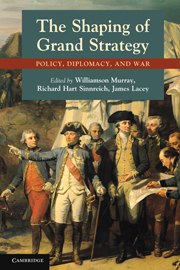Book contents
- Frontmatter
- Contents
- Contributors
- 1 Thoughts on grand strategy
- 2 The grand strategy of the grand siècle: Learning from the wars of Louis XIV
- 3 Strategic culture and the Seven Years' War
- 4 Strategy as character: Bismarck and the Prusso-German question, 1862–1878
- 5 About turn: British strategic transformation from Salisbury to Grey
- 6 British grand strategy, 1933–1942
- 7 Toward a strategy: Creating an American strategy for global war, 1940–1943
- 8 Harry S. Truman and the forming of American grand strategy in the Cold War, 1945–1953
- 9 Patterns of grand strategy
- Index
7 - Toward a strategy: Creating an American strategy for global war, 1940–1943
Published online by Cambridge University Press: 05 June 2012
- Frontmatter
- Contents
- Contributors
- 1 Thoughts on grand strategy
- 2 The grand strategy of the grand siècle: Learning from the wars of Louis XIV
- 3 Strategic culture and the Seven Years' War
- 4 Strategy as character: Bismarck and the Prusso-German question, 1862–1878
- 5 About turn: British strategic transformation from Salisbury to Grey
- 6 British grand strategy, 1933–1942
- 7 Toward a strategy: Creating an American strategy for global war, 1940–1943
- 8 Harry S. Truman and the forming of American grand strategy in the Cold War, 1945–1953
- 9 Patterns of grand strategy
- Index
Summary
When, in 1940, German panzers overran France and the Low Countries in a matter of weeks, it was apparent to all but the most obtuse that a tectonic shift in the global strategic situation had occurred. With France out of the war, Britain stood alone against the overwhelming might of Germany with seemingly little chance of surviving the Luftwaffe's onslaught. America, however, was slow to formulate a grand strategy. Even though President Franklin Delano Roosevelt fully recognized the extent of the change, he remained constrained by the domestic politics of the United States.
Roosevelt was running for an unprecedented third term in 1940 with the promise that American boys would not die in foreign wars. In spite of his public stand, he took the extraordinarily dangerous step of providing significant military aid to Churchill's beleaguered government, military aid that America's own military forces desperately needed and that could only be released by a declaration that such equipment was surplus to U.S. needs – a declaration that his service chiefs were loath to make, especially considering how bare their cupboards were. And even after Roosevelt had won the election, he still confronted a large, active, and politically influential movement dedicated to ensuring the United States would remain out of the conflict.
- Type
- Chapter
- Information
- The Shaping of Grand StrategyPolicy, Diplomacy, and War, pp. 182 - 209Publisher: Cambridge University PressPrint publication year: 2011

